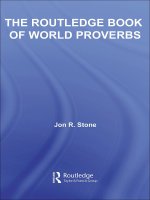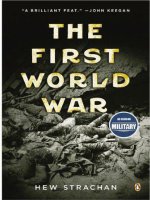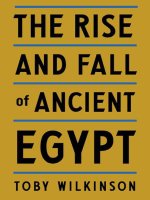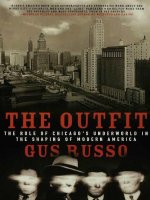Alan dale daniel the super summary of world history (v5 0)
Bạn đang xem bản rút gọn của tài liệu. Xem và tải ngay bản đầy đủ của tài liệu tại đây (6.23 MB, 421 trang )
Copyright © 2010 by Alan Dale Daniel, BA, MBA, JD.
Library of Congress Control Number: 2008904529
ISBN:
Hardcover
978-1-4363-4326-8
Softcover
978-1-4363-4325-1
Ebook
978-1-4500-6251-0
All rights reserved. No part of this book may be reproduced or transmitted in any form or by any means, electronic or mechanical,
including photocopying, recording, or by any information storage and retrieval system, without permission in writing from the copyright
owner.
This book was printed in the United States of America.
To order additional copies of this book, contact:
Xlibris Corporation
1-888-795-4274
www.Xlibris.com
49740
Contents
Time Line of World History
Introduction
Top 20 Events in History (my opinion)
Chapter 1
Prehistory 150,000 BC to 3,500 BC (approximate)
Ten Human Traits
Neolithic Revolution—Agriculture 8,500 BC
Differing Views of History
Books and References:
Chapter 2
Ancient History 8000 BC to AD 455
Geography
Security
Sumer and UR
Abraham
Egypt
Mesopotamia
The Bronze Age Collapse
Harappan Civilizations—Indus Valley
The Aryans and Iron Age Civilizations In India
Greece and Rome
The Greeks
Individual Greater than the State
Of Gods and Governments
The Persians Invade Greece
After the Persians—The Peloponnesian War
Alexander the Great
Rome
The Punic Wars
Cannae
The Army, the Republic, and the Empire
Discussion of the Fall of the Western Roman Empire
The Need for Protection
Invaders from the Center of the World
Greek Philosophy
Sophists
Of Gods and Men
The Role of Food, Disease, and Administration in Ancient Times
Books and Resources
Books and References on Philosophy
Chapter 3
The Dark Ages 455 to 1400
Total Loss Of Roman Culture
Events of the Dark Ages
The Catholic Church
Feudalism
The Guild System
Government During The Dark Ages
The Franks—France
England
The Viking Raids
The Mongols
Europe Battles Toward the Renaissance
Books and Resources
Chapter 4
The Renaissance 1300 to 1500
New Thoughts and New Assumptions
Science and Pseudoscience
The Art of Oil Painting
Books and Resources
Chapter 5
The Age of Discovery 1463 to 1522
Native Empires in the Americas
Spanish and English Empires in the Americas
Books and Resources
Chapter 6
The EAST
China
The Dynasties (this can get very dull)
Japan
Korea
India
Books and Resources
Chapter 7
Africa
Books and Resources
Chapter 8
The Middle East and the Fall of Byzantium (The Eastern Roman Empire) 500 to 1453
Islam Turned Back at Tours
Byzantium
The Crusades
Books and Resources
Chapter 9
The New World and the Rise of America
Columbus and 1492
Native Americans
The American Revolution 1775 to 1782
Background
Lexington and Concord—the War begins
The Declaration of Independence
Early Defeats and Trenton—the Last Chance
Saratoga
The American Frontier
The Constitution of the United States of America
Problems—Discussing the Constitution
Books and Resources
Chapter 10
Europe from the Renaissance to 1900
Nation States, Religion, War, and The Armada
Europe Undergoes Vast Change
Science and the Printing Press (The Road to Tomorrow)
The Arts—Painting
Speed of Change
The French Revolution 1789 to 1799
The Impact of Empires
The Industrial Revolution
Art and the Future of Europe
Rise of New Nations in Central Europe
Chapter 11
America and the Americas
Latin America
United States of America
The War of 1812
American Growth and Problems
Mexican-American War
The American Civil War 1861 to 1865
Causes
The time line to war:
Casualties
Strategy—the North
Strategy—the South
The War Begins
Antietam and Emancipation
Gettysburg
Grant and Sherman Destroy the South
Grant
Sherman
Reconstruction of the South
Aftermath—the Impacts of the Civil War
Books and Resources
From the Civil War to 1900
Industrial Expansion
America Becomes an Imperial Power—1898
Copying Britain
Books and Resources
Chapter 12
1900: The Dividing Line to the Modern World
Industrialism and the Machine Age
Machines
Politics
America
Power of Women
Power of the Press
Power of Religion
Power of Science
Art and Literature
The Power of Change
Chapter 13
The First World War 1914 to 1918
Casualties
Financial Costs
Other Costs
Causes of the Great War
The von Schlieffen Plan
Mobilization
Deciding Factors (in order of importance)
The War Begins
Stalemate in the West
the Western Front
The Russian Front
The War at Sea
New Technology
The Eastern Front and Revolution
Other Fronts
Turning Point: The United States of America Enters the War
Aftermath
Some Thoughts on the Great War and the Aftermath
Books and Resources on the Great War
Chapter 14
The Interwar Years 1919 to 1939
The Great Depression 1929-1942?
Background
Causes
The Contraction Starts
Hoover and Roosevelt—The Twins of Economic Failure
Economic Theories
European Government’s under Stress: Fascist and Communist
Japan Taken Over By Militarists
The Future Goes Dark
Books and Resources on the Great Depression and the Rise of the Third
Reich
Chapter 15
World War II 1939 to 1945
How Many Dead?
Compare 1914 and 1939
Deciding Factors
World War II Begins
The Battle of France
Battle of Britain
Invasion?
The Battle of the Atlantic
Industrial Production
The Crucial Years
North Africa
El Alamein
The USSR
Barbarossa
Japan Enters the War December 7, 1941
Background
Deciding Factors In the Pacific
Pearl Harbor And the Japanese Centrifical Offensive
Pearl Harbor
Japans’ Southern Offensive
Singapore
The Philippines
The Battle of Midway
The South Pacific and Indochina
Guadalcanal
Midpoint in the Second World War Europe: Key Decisions
Axis (mis) Management
Hitler Attacks in the East
War In The Atlantic
North Africa
Sicily and Italy
Planning D-Day
Midpoint in the Second World War—Pacific
Tarawa
Marianas and New Guinea
The Philippines—The Return of the USA
Hammering Toward Victory—The Pacific
Battle of Leyte Gulf—the Philippines
Submarine Efforts—Axis and the Allies
Hammering Toward Victory—Europe
D-Day and Beyond
Background to D-Day
The Atlantic Wall Breached
The Battle of the Bulge
The Air War Over Europe
The Eastern Front—After Stalingrad
The End in Europe
The End in Asia
Battle of Okinawa
Operation Olympic
Truman Uses the A-Bomb
Books and References
Chapter 16
The Cold War 1945 to 1989
Truman: Neophyte Cold Warrior
Eisenhower: Careful Cold Warrior
Kennedy: Risk-Taking Cold Warrior
Lyndon B. Johnson: Worthless Cold Warrior
Nixon: Winning Cold Warrior
Carter: Incompetent Cold Warrior
Reagan: Ultimate Cold Warrior
Books and Resources
Chapter 17
The Korean War
Background to Invasion
The Red Empires Strike!
Inchon The UN Allies Strike Back
China Enters the War
The New Air War
UN Forces Move North—Again
Stalemate
Use the Bomb—or Not?
Analysis
Chapter 18
The Vietnam War
Background
Eisenhower Stays Out
The Fall of Dien Bien Phu
America Steps In (it)
Johnson Commits US Troops—1964
Tet Offensive
Nixon Gets the United States Out
The South Falls
After the Fall
Why? The Analysis of the War and its Aftermath
Books and Resources
Chapter 19
The Postmodern World . . . or Not?
The Long View of History
What About the West is Unique?
Modern Philosophy—of the west
Propaganda
Beyond the Cold War
Technology
War
US Civil Rights Movement
Bureaucracy in the Modern World
The Future and our Ability to Discern the Future
A Final Thought
Online Sources
Table of Figures
Time Line of World History
Not all events in this time line are covered in the text.
Taking the Long View
After about 1980, it is difficult to say what we are studying is “history” because it is still within the
lifetimes of most people, and in such cases the “long view” of history is lost. In fact, I would have to
say that anything occurring after 1950 is probably not history. It is best that “history” is written by
people who were not alive at the time of the events and not affected by the emotions of the time
including emotions passed down from their parents or their friends. My writings herein on Vietnam
suffer from the prejudices of my age and my political positions both at the time of the war and now in
the aftermath of the war and its perceived impact on the war in Iraq and the War on Terror. Even
writing about the Great Depression is somewhat hard because my dad was alive during the
Depression and told me a lot about his experiences during that time; thus, my view is colored by those
remembrances. However, no one is ever free of prejudices and history has a lot to do with forming
those prejudices. Nonetheless, I have written this history to include the Cold War up to its end in
1989 but very little thereafter. So, readers, beware of what anyone says about events within their
lifetime. The long view will sort it all out. For now, be aware that like it or not my prejudices will
come through no matter how much I try to suppress them. This is true of everyone, although some may
be better at avoiding the pitfalls than others. The key is to be aware that no one is without a point of
view, and most people who want to write about anything have very strong points of view. Awareness
is the key. Have fun!
AD2
Introduction
We are going to do an extreme summary of world history with a heavy concentration on Western
Europe and the United States of America. Using this method, we will first lay a foundation so the
pieces of history will have a place to fit as we study them. It is like looking at the picture before you
build a puzzle; it makes it easier. After reading this summary you should be able to pick up any
detailed history book and quickly understand where the era fits into the total stream of history.
A little background on your author will help you understand his point of view. I was born in 1947 in
Bakersfield, California, my dad died just after I graduated from High School, I earned a BA in history
from San Fernando Valley State College (California State Northridge now) by working my way
through, and then, from 1970 to 1975, I served as a helicopter pilot for the United States Marine
Corps. While in the marines, I went to night school and earned my MBA from Pepperdine University.
After the marines, I attended law school, obtained a JD from Pepperdine University School of Law in
1978, and passed the California bar that same year. I was a California attorney for over twenty-five
years in both private and public practice. The City Attorney’s Office for the city of Bakersfield hired
me in 1984 and I spent twenty years as their water law attorney (among many other things) leaving the
city in 2004.
My thesis study for my history degree was Herodotus, probably the greatest historian ever, even
though Thucydides was probably just as good. Both Greeks, both fun to read, and both about as
impartial as a person can get while still breathing.
In this work I attempt to be impartial, as all historians should; however, I am prejudiced as all of us
are, and by knowing that I am a staunch conservative Republican and a Christian will aid you in
processing my writings, helping you know why I think some things are very important and others not
so much. I like to compare events. How were the priesthoods in Egypt and the Dark Ages alike? Why
didn’t China fall, as Rome did, into a complete collapse after conquest from outside invaders? Art in
Europe seems to predict the future, but art in the East does not. Why is this? And so on. By comparing
cultures and trying to notice similarities and differences between them, we can learn at a deeper level
than simply memorizing bare sets of facts.
The history of our world can be divided into sections, and here are the ones we will use:
Prehistory (before the written word—150,000 BC to about 8000 BC in the near east)
The most important events in human history occur here: agriculture, writing, societal organization
Ancient history (8000 BC to about AD 455 or the fall of Rome)
The rise of cities and complex administrative organizations
The Dark Ages (AD 455 to AD 1300)
The failure and disintegration of Roman Western civilization and societal organization in Europe.
Renaissance (AD 1300 to AD 1500)
Rediscovering ancient wisdom and moving beyond, with the help of science and the printing press
Age of Discovery to World War I (1500 to 1914)
Europe finds out that the world is a large place, and then devours it while building a golden age of progress
World War I (1914 to 1918)
WWI cracks the Western world, then the Great Depression shatters it as the West totters on the brink of total
economic and social collapse
Interwar Years and World War II (1918 to 1945)
The entire world tumbles into another total war, and then crawls over broken landscapes into the future
Cold War (1945 to 1989)
As the world rebuilds and rearranges itself, a twilight war rages menacing all, and after it fades the future darkens yet
again with new threats of religious wars without end
Postmodern History (End of the cold war in 1989 and beyond . . . well, a little beyond)
Technology makes breathtaking advances while humanity’s thoughts grow cold and dark. New wars erupt with new
methods of killing. What will rule the future, destruction or progress? Does progress really exist?
The invention of agriculture and animal husbandry was THE most important event in secular
history. The invention of writing and the invention of the printing press were some of the next most
important events, but nearly every historian will agree that without agriculture and animal husbandry
the world would be a far different place. Religious folks will say the advent of their religious leader,
such as Jesus Christ, Mohammad, or Buddha for example, was by far the most important event in
history; however, that leads to a decision based solely on religion and a religious leader’s impact. A
Christian is not going to say the birth of Buddha was more important than the birth of Jesus. Because
of this, I will stay away from proclaiming the start of a religion as the most important event in history
although the start of the great religions truly was of immense importance.
Just for fun, let’s guess at the top twenty events in world history (based on how they influence our
present world), in order of importance (religion excluded). Here is my list. Does your list match?
Top 20 Events in History (my opinion)
1. The Invention of Agriculture and Animal Husbandry (8,500 BC). The Neolithic Revolution.
This will also include the invention of spoken language, the wheel, metallurgy, social order
(government), and the idea of god and an afterlife (maybe), to name a few other “minor”
items that go along with 8500 BC. As far as importance, nothing else comes close.
2. The invention of writing (5,000 BC).
3. The invention of the Printing Press (AD 1430).
4. The Discovery of the Scientific Method (AD 1469, Natural History published).
5. Tesla & Electricity Generation (AD 1881, first US Electrical power plant).
6. World War I, and World War II ( AD 1914-1945).
7. World Population explosion (AD 1800 on).
8. The Start of the Latest Interglacial Period (15,000 BC).
9. The Fall of the Western (AD 455) and the Eastern Roman Empire (AD 1453).
10. The Discovery of the New World (AD 1492).
11. The Industrial Revolution (AD 1804, first locomotive).
12. The Black Plague (AD 1341 China, 1347 Europe).
13. Pasteur’s theory of germs (AD 1864). Start of medical advances.
14. The Invention of Flight ( AD 1903). Leads to satellites, moon landing, jet aircraft etc.
15. The rise of Megacities (AD 1950).
16. The Invention of the Microprocessor (AD 1971, first types).
17. The Invention of the telephone (AD 1876). Leads to radio, TV, cell phones, etc.
18. Plato, Aristotle ( 429 BC). Philosophy begins.
19. The Theory of Relativity and Quantum Mechanics (AD 1905). Start of modern science.
20. The Invention of the Internet (AD 1974).
_______________________________________________________
21. The philosophic/religious Wars of Communism (1917)
Some of these items, such as the telephone, represent the start of a tremendous advance covering many
areas. Religious events are excluded. Which was more important, the birth of Christ, Mohammad,
Buddha, or Lao Zi? All this will depend upon one’s religious beliefs, so all of them are excluded.
In this study of history, I conclude that people are both rational and irrational. In matters of science,
engineering, and basic economic decisions people are at least 80 percent rational; however, in
matters of politics, religion, social interaction, philosophy, and law people are at least 80 percent
irrational. This dualistic nature of humankind is the source of many problems, and it is seemingly part
of our genes. In this case, rational means the actions (or events, or results) can be understood on many
levels by most people, can be copied for the betterment of all (or the vast majority), and can be built
upon for advancement. Irrational is the opposite in that the actions cannot be understood on any level
by most people, and if copied or built upon would bring immense harm.
Throughout this history I have sacrificed exactness for readability. Many statements are “slam dunk,”
such as, in the reign of Augustus, the Pax Romana ushered in two hundred years of peace. Well, in
fact, it did not because there was at least one civil war within the empire and other minor wars on the
boarders, but to go into all the detail would destroy the readability of the text and ruin the super
summary concept.
I apologize for the quality of the maps herein. Please use the Internet references to see the maps (and
photographs) in full color, and in a size that is easy to read. The Internet, especially Wikipedia and
Olga’s Gallery (), is a wonderful source for viewing historical art in full
color.
Good reading!
AD2









